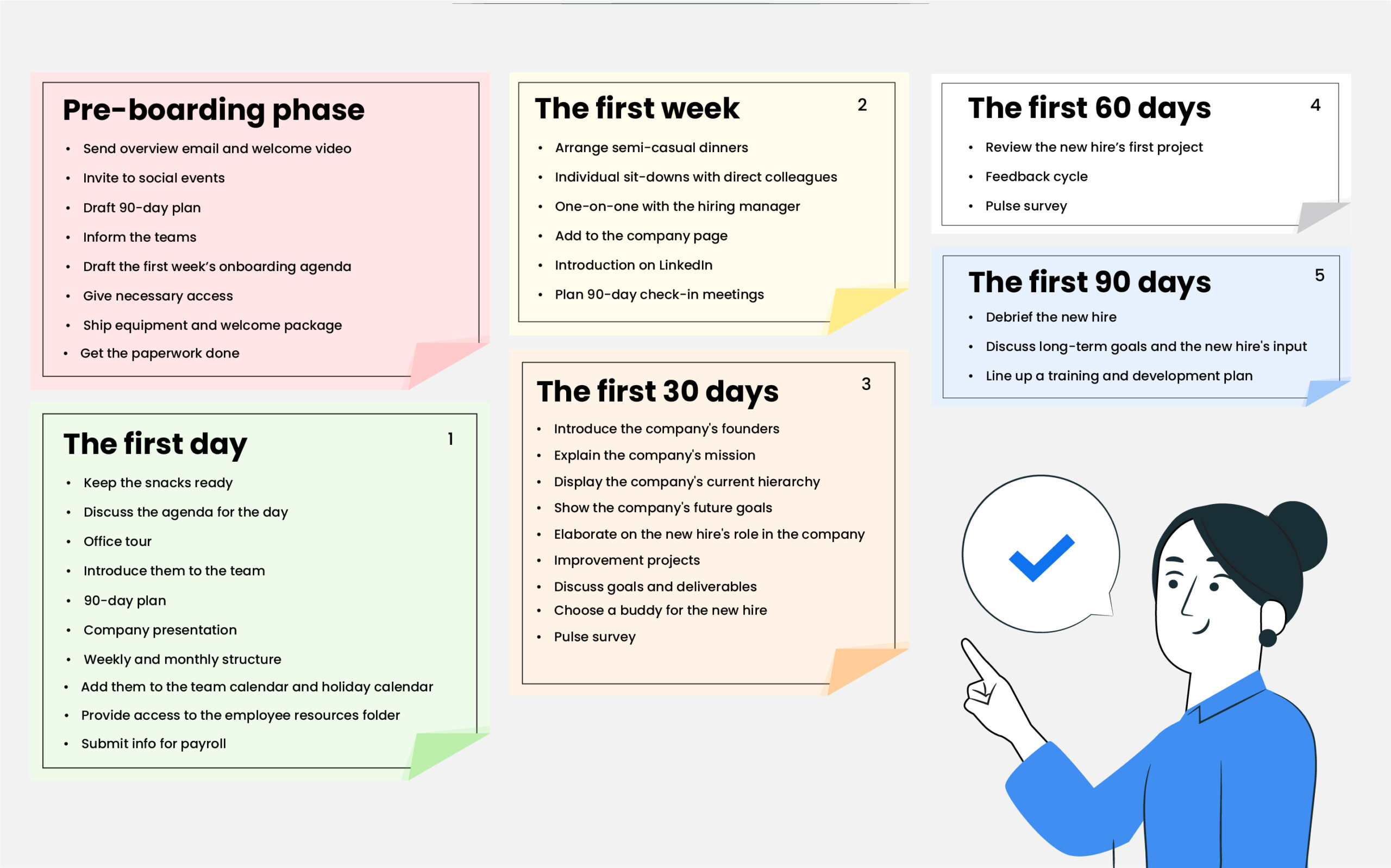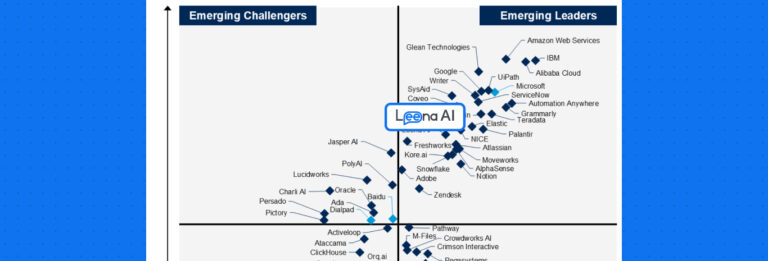Onboarding a new employee involves several dynamic elements closely knitted together. Hence, preparation for proper onboarding takes time and ideally even starts before the joining date.
Another essential aspect to consider here is the changing work model across organizations. Many companies are adopting remote and hybrid work structures, making the multi-stage onboarding process even more complex.
But effective onboarding is essential for employee engagement, retention, and productivity. To ensure HRs conduct all the operations with uniformity, they need a well-mapped-out new hire checklist. It ensures that every crucial element gets noticed during the six onboarding stages, i.e., preboarding, the first day, the first week, the first month, and the first 90 days post-joining.
Read this article to streamline all your five stages of the onboarding process through a comprehensive checklist.
How to streamline the onboarding process across the six stages

Preboarding phase
1. Send overview email and welcome video:
In this initial email, send the offer letter and brief the new hires about their daily office life details, including information on accessing the company’s internal network. This way, you will avoid any potential scenarios of going back and forth with IT on Day 1. Also, send a welcome video from the founders. It will make the experience more personal for the new hires during the preboarding.
2. Invite to social events:
Invite them to attend a social event with the team. This way, they can connect with their colleagues before joining the position and foster a bond.
3. Draft a 90-day plan:
The 90-day program is fundamental to the employee onboarding checklist, giving new hires clarity on their future at the company. Take preboarding as an opportunity to craft the 90-day plan detailing future deliverables, upcoming projects, etc.
4. Inform the teams:
Brief them on the new hires a day before their joining date. Keep everyone up to date with their roles as they welcome their new teammates.
5. Draft the first week’s onboarding agenda:
To avoid mishaps, finish drafting the agenda early in the preboarding phase. You will have clarity on the exact chronology of the steps. As this requires the active participation of multiple people, planning for the first day will give you enough window to accommodate any unforeseen changes.
6. Give necessary access:
Ensure that new hires have relevant access to the required portal and tools. This way, they will have credentials to log in on their own from the very first, keeping the workflow going.
7. Ship equipment and welcome package:
Allow your new employees to get familiar with the system in the preboarding phase by shipping all the equipment early on. Send them their welcome kit as well to add an extra touch of warmth.
8. Get the paperwork done:
Onboarding usually involves a lot of forms and agreements for the new hire to sign, which takes a considerable chunk of day 1. Consider sending over digital documents in the preboarding phase and ask the new hires to e-sign them. This way, they can clarify any doubts and be clear on all the regulations before the joining day.
9. Choose a buddy for the new hire:
Assign your new hires a work buddy. They will help the new hires acclimatize to the company culture, gel with the team, assist them with their tasks, and check in on them regularly.
The first day
1. Keep the snacks ready:
Your new employee onboarding checklist should focus on making the first day as festive as possible for them. Welcome them with a snack bar of cakes, pastries, chips, and drinks. Keep some healthy options ready for fitness enthusiasts as well. This could be an excellent opportunity for the new hires to socialize with their colleagues and get introduced to the company culture.
2. Discuss the agenda for the day:
The first day is everything you were preparing for. Discuss the day one schedule with the new hires to ensure all your effort pays off. This way, they know exactly what to expect on their first day and are mentally prepared for it.
3. Office tour:
Show them where they will spend most of their day. Offer them a pantry tour, explain how the coffee machine works and where the washrooms are, and show printers and other standard equipment for a seamless work experience.
4. Introduce them to the team:
The most critical part of the employee onboarding on the first day is introducing the new hires to their respective team members. Plan one-on-one meetings with the team leaders on the first day. They can brief new hires on the procedures to be followed and acclimatize them with their teammates.
90-day plan:
Introduce the new employee to their 90-day plan later in the day. Provide them with a written copy of the agenda and an extensive explanation of all the distinct elements. As discussed, this part is the key element in the employee onboarding checklist and should be articulated to the employee carefully.
1. Company presentation:
Deliver a presentation by the leadership, primarily focused on the mission and vision, how the company works with different teams and roles, and its inherent culture. It should mention how appreciative the new hires are in the company and how the leadership looks forward to working with them.
2. Weekly and monthly structure:
To spare new hires any unnecessary confusion, prepare a detailed weekly and monthly work structure. Detail the tasks they need to complete in a week, how to do them, and whom to reach for any queries. Explain deadlines and the quality you are expecting. Include examples if you can.
3. Share holiday calendar:
Add the new employee to every relevant calendar. This ensures they attend all important events and can be prepared for them beforehand.
4. Provide access to the employee resources folder:
Give them the employee handbook, expense forms, training modules, and other vital resources on Day 1. This way, they can go through them and apply the structure in their work from the very first day.
5. Submit info for payroll:
If there are any mishaps in crediting a new hire’s salary in the very first month, your company’s employee experience will go downhill quickly. Hence, logging new employees’ information on the payroll should be one of your priorities in the onboarding checklist. Consider using automation to avoid any errors.
The first week
1. Arrange semi-casual dinners:
To help your new hires get over onboarding jitters, ask them to pick a restaurant and order takeout on Friday. You can also take them to an excellent restaurant and make them feel valued.
2. Individual sit-downs with direct colleagues:
Although this should already occur on the first day, you can also arrange one-on-ones in case some colleagues were away on Day 1. All-in-all, your employee onboarding checklist should map the complete sit-downs with direct colleagues for the first week.
3. One-on-one with the hiring manager:
During the first week, the new hire onboarding checklist details one-on-one meet-ups with the hiring manager. They will connect with the new hire at the end of the week and recap their experience. They will evaluate what went well and what could be better and examine whether additional factors need attention. Keep resources ready to accommodate your remote employees virtually.
4. Introduction on LinkedIn:
Always share about your new employees on LinkedIn. This action could build a closer connection with your consumers and result in immediate interaction with the new hires.
5. Plan 90-day check-in meetings:
The checklist for employee onboarding should always revisit the 90-day plan from time to time. Plan the monthly evaluation of the 90-day program in the first week itself. A structured process at every stage will ensure a smooth completion of the agenda.
The first 30 days
1. Introduce the founders:
Introduce your new hires to the company founders in the first month. Arrange a session where the founders narrate how they incepted the company, its ethos, how they want to impact society, etc. Include a Q&A session to let new hires ask the questions from founders and get inspired by them.
2. Explain the company’s mission:
The key to engaging new joiners is to explain to them what impacts their contributions will have. Tell them about your mission and vision and how their job roles fit.
3. Display the company’s current hierarchy:
Corporate hierarchy refers to the arrangement of professionals within a corporation according to power, status, and job function. Give your employees a clear idea of your current hierarchy. You can use diagrams to explain it to them effectively.
4. Show the company’s future goals:
The onboarding checklist for new employees must include elaboration on the company’s plans. This makes it easier for the new hires to align their growth with the company.
5. Elaborate on the new hire’s role in the company:
Further, elaborate on their role in the company. Ask them whether there is any confusion regarding what they have learned about their duties.
6. Improvement projects:
Start giving them more responsibilities. Examine how they perform. If you see areas for improvement, conduct dedicated training sessions focused on that.
7. Discuss goals and deliverables:
Arrange one-on-one meetings to discuss the previously communicated deliverables for the month. Ask the new hires whether they need any pointers or resources regarding the tasks. You can also discuss how they plan to complete the assigned work on time.
8. Pulse survey:
Include pulse surveys in the employee onboarding checklist to gather information on their experience. Analyze the collected data and take immediate action on the insights you find. That way, you will make your employees trust you with their issues and significantly enhance their experience in the future.
The first 60 days
1. Review the new hire’s first project:
To track how the new hire fits in their job role, evaluate their first project. Identify areas where they excelled and find out points that need improvement. This will give you practical insights into your new employee’s capabilities and skills.
2. Feedback cycle:
Create a feedback cycle based on what you find through the evaluation. Appreciate them for their hard work, congratulate them where they excelled, and provide constructive criticism on areas that need improvement. Show them how they can do well. This should be frequent and consistent throughout all the departments.
3. Pulse survey:
Conduct pulse surveys again to evaluate your next 30-day phase of the onboarding process. This should be a regular addition to your new hire checklist.
The first 90 days
1. Debrief the new hire:
Recap the new employee’s performance in the 60-day phase. Highlight the areas for improvement by including tangible data in the discussions.
2. Discuss long-term goals and the new hire’s input:
Brief the recruits on what the company views as their long-term goal in the job role. Make them understand the difference their position makes in the business outcomes.
3. Line up a training and development plan:
By now, you should have enough data to evaluate the strong and weak points of the new employees. Use that and develop personalized training and development plans for each hire. The idea here is to give them all resources possible and help them improve and thrive in their work.
To get a comprehensive employee onboarding checklist in PDF, download it from here.
Conclusion
While all the above points are necessary for an all-inclusive employee onboarding checklist, a singular structure will not accommodate employees with distinct skill sets and roles.
To design checklists that work for your new hires, you need to track and monitor their progress and performance at each step of the onboarding plan. This way, you can identify where you can implement automation and improve for better productivity and employee experience.
Constantly checking employee engagement through onboarding is not possible with the manual method. For accurate results, you need to leverage technology — and Leena AI can help you do that.
Leena AI’s employee onboarding solution uses an AI-powered virtual assistant to automate the entire process. It helps HRs release offer letters, assigns onboarding buddies automatically, notifies IT and other departments about new hires’ joining, and ensures that paperwork gets done hassle-free.
Besides, once a new employee joins, it sets up introductory calls with team members, leaders, and managers, as required, and rolls out pulse surveys also after 30/60/90 days.
Leena AI’s onboarding solution is customizable and scalable to let HRs tweak the workflow and meet their unique business requirements. Further, the multilingual capability brings in personalized touch to the new hires, fostering seamless communication and more engagement.
If you are interested in exploring similar and more capabilities of our onboarding software for your enterprise, book a demo now!
FAQs:
What is an employee onboarding checklist?
The employee onboarding checklist encompasses activities your new employees must complete to gain access to company resources and start working effectively. These activities include, but are not limited to, getting a company email account, receiving training, getting their computer from the IT department, and attending a brief welcome meeting.
The objective is to ensure that new employees can effectively perform their job duties and that your most valuable assets, employees, are happy and productive.






